West Virginia Mountaineers football
The West Virginia Mountaineers football team represents West Virginia University (also referred to as "WVU" or "West Virginia") in the NCAA Football Bowl Subdivision (FBS) of college football. West Virginia plays its home games on Mountaineer Field at Milan Puskar Stadium on the campus of West Virginia University in Morgantown, West Virginia. The Mountaineers compete in the Big 12 Conference.
| West Virginia Mountaineers football | |||
|---|---|---|---|
| |||
 | |||
| First season | 1891 | ||
| Athletic director | Shane Lyons | ||
| Head coach | Neal Brown 2nd season, 5–7 (.417) | ||
| Stadium | Mountaineer Field at Milan Puskar Stadium (Capacity: 60,000[1]) | ||
| Year built | 1980 | ||
| Field surface | FieldTurf | ||
| Location | Morgantown, West Virginia | ||
| NCAA division | Division I FBS | ||
| Conference | Big 12 Conference | ||
| Past conferences | Independent (1891–1924, 1928–1949, 1968–1990) WVIAC (1925–1927) SoCon (1950–1967) Big East (1991–2011) | ||
| All-time record | 755–498–45 (.599) | ||
| Bowl record | 15–22 (.405) | ||
| Conference titles | 15 SoCon: 1953, 1954, 1955, 1956, 1958, 1964, 1965, 1967 Big East: 1993, 2003, 2004, 2005, 2007, 2010, 2011 | ||
| Rivalries | Marshall (rivalry) Maryland (rivalry) Penn State (rivalry) Pitt (rivalry) Syracuse (rivalry) Virginia Tech (rivalry) | ||
| Consensus All-Americans | 11 | ||
| Current uniform | |||
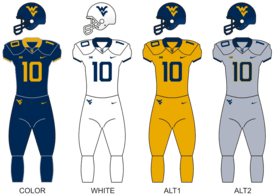 | |||
| Colors | Gold and Blue[2] | ||
| Fight song | Hail, West Virginia | ||
| Mascot | The Mountaineer | ||
| Marching band | The Pride of West Virginia | ||
| Outfitter | Nike | ||
| Website | wvusports.com | ||
With a 752–495–45 record as of the conclusion of the 2018 season, WVU ranks 14th in victories among NCAA FBS programs, and has the most victories among those programs that never claimed nor won a national championship. West Virginia was originally classified as a College Division school in the 1937 season, and joined the University Division, forerunner of Division I, in 1939. It has been a member of Division I FBS since 1978 (known as Division I-A until 2006).[3] The Mountaineers have registered 82 winning seasons in their history, including one unbeaten season (10–0–1) in 1922 and nine seasons with at least ten wins (1922, 1969, 1988, 1993, 2005, 2006, 2007, 2011, 2016).[4] The Mountaineers have won or shared a total of 15 conference championships, including eight Southern Conference titles and seven Big East Conference titles.
History
Early years (1891–1920)
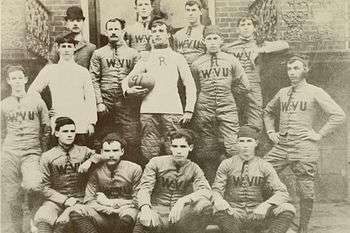
The West Virginia University football program traces its origin back to November 28, 1891 when its first team fell to Washington & Jefferson 72–0 on a converted cow pasture.[5] Despite its humble beginning, West Virginia enjoyed a 25–23–3 overall record prior to 1900, which proved to be a fruitful century of Mountaineer football. The early 1900s brought about early successes for the program, namely during the 1903 and 1905 seasons when WVU posted records of 7–1 and 8–1 respectively.[4] WVU produced a 6–3 record in the 1904 season, despite losing to Penn State, Pitt, and Michigan by a combined score of 217–0.[6] The 1908–20 period produced the four-year head coaching tenures of C.A. Lueder (1908–11) and Mont McIntire (1916–17, 1919–20), representing the longest coaching tenures during this early period of Mountaineer football. Lueder's Mountaineers produced a 17–13–3 record, while McIntire's teams produced the most success of any Mountaineer team prior to 1921, compiling a 24–11–4 record including an 8–2 finish in 1919.[4] That same Mountaineer team also produced West Virginia's first ever Consensus All-American and potential College Football Hall of Fame inductee, Ira Errett Rodgers.[5] Rodgers scored 19 touchdowns and kicked 33 extra points for WVU in 1919 season, leading the nation with 147 total points. Rodgers also threw 11 touchdown passes that season, an unheard of feat at the time and a Mountaineer record until 1949.[7]
Spears and Rodgers era (1921–1931)
The Mountaineers enjoyed their first period of success during the 1920s, coinciding with the successful coaching tenures of Clarence Spears (1921–24) and Ira Errett Rodgers (1925–30, 1943–45). Under the tutelage of Spears, West Virginia compiled a 30–6–3 record with its best performance coming in the 1922 season. The 1922 edition of the Mountaineers remains the only team in West Virginia history to produce an unbeaten season, finishing with a 10–0–1 mark.[4] Spears's Mountaineers surrendered only 34 total points in 1922, posting six consecutive shutouts to finish the regular season.[8] The 1922 season also produced notable victories against rival Pitt and against Gonzaga in the East-West Bowl, the program's first bowl game appearance. Offensive tackle Russell Meredith garnered First-Team All-American honors. In homage to the successes of the 1922 season, West Virginia University undertook construction of what became the first incarnation of Mountaineer Field.[5]

The Mountaineers continued their success under Spears in posting subsequent one-loss seasons in 1923 (7–1–1) and in 1924 (8–1), with Spears departing the program for Minnesota thereafter. Ira Errett Rodgers replaced Spears and the Mountaineers posted an 8–1 record in 1925. After a 6–4 finish in 1926 and a 2–4–3 record in 1927, the program produced an 8–2 finish in 1928.[4] Rodgers's first tenure as West Virginia coach ended with records of 4–3–3 in 1929 and 5–5 in 1930.[4]
Neale, Tallman and Glenn era (1931–1939)
Taking over for Rodgers in 1931 was Earle "Greasy" Neale, but his tenure was short-lived as the Mountaineers failed to produce a single winning season under his guise, going a combined 12–16–3 over Neale's three years as coach.[4] Charles Tallman, an End who achieved All-American status with the Mountaineers in 1923 with the Mountaineers, replaced Neale in 1934 and produced immediate results as the program posted 6–4 records in 1934 and 1936.[4] Although West Virginia posted a 3–4–2 record in 1935, the program produced an All-American in Joe Stydahar, an offensive tackle. "Jumbo Joe" later became both a College Football Hall of Fame and Pro Football Hall of Fame inductee. Despite his winning record, Tallman resigned after the 1936 season to pursue his career in law enforcement as Superintendent of the West Virginia State Police.[9]
Marshall Glenn picked up right where Tallman left off, leading West Virginia to an 8–1–1 record in 1937. The season concluded with an upset of Texas Tech in the 1938 Sun Bowl.[10] Running back Harry Clarke led the way for the Mountaineers that season, rushing for a then school record 921 yards and 10 touchdowns.[11] Glenn's success was short-lived, however, as subsequent WVU teams posted losing records of 4–5–1 in 1938 and 2–6–1 in 1939, leading to his ouster.[4]
Kern, Rodgers, and DeGroot era (1940–1949)
West Virginia experienced a lag in success during much of the 1940s, producing only three winning seasons while witnessing the split coaching tenures of Bill Kern (1940–42, 1946–47) and the second appearance of Ira Errett Rodgers (1943–45).[4] Under the direction of head coach Dudley DeGroot in the 1948 season, the Mountaineers returned to prominence with a 9–3 finish, adding another Sun Bowl victory to its resume with a 21–12 defeat of Texas Western (now known as UTEP).[12] Despite that successful first season at the program's helm, DeGroot resigned after a disappointing 4–6–1 finish in 1949.[13]
Art Lewis era (1950–1959)
.jpg)
When Art "Pappy" Lewis became West Virginia's head coach in 1950, he remarked that it was the job that he had always wanted.[13] Known by his peers as an exceptional recruiter and by his players as a father figure, Lewis established a family-like atmosphere within the Mountaineer football program.[13] Lewis's Mountaineer teams held true to form, experiencing their most consistent success during the 1950s as it ever had previously. After forgettable campaigns in 1950 and '1951, the 1952 season brought WVU its first winning season since 1948. The Mountaineers finished with a 7–2 record, highlighted by a 16–0 upset victory of No. 18 Pitt in Pittsburgh.[14]
Beginning with the 1953 season, the Mountaineers would reel off three consecutive eight-win seasons and five Southern Conference (SoCon) championships in six seasons.[4] In 1953, the Mountaineers finished with an 8–2 record, their first SoCon championship, a No. 10 ranking in the Associated Press (AP) Poll, and a berth in the Sugar Bowl with Georgia Tech.[15] The 1954 edition of the Mountaineers also finished the regular season with an 8–1 mark, losing their only game to Pitt by a 13–10 score. The Mountaineers did not earn a bowl bid, however, despite winning their second consecutive SoCon title and earning a No. 12 ranking in the AP Poll.[16] In 1955, the Mountaineers engineered yet another eight-win season and SoCon championship, but upset losses to Pitt and Syracuse doomed West Virginia's shot at a bowl bid.[17] Despite its disappointing finish, WVU produced two All-American offensive linemen and future College Football Hall of Fame inductees in Bruce Bosley and Sam Huff. Bosley earned Consensus All-American status that season, becoming the first Mountaineer to do so since Ira Errett Rodgers in 1919.
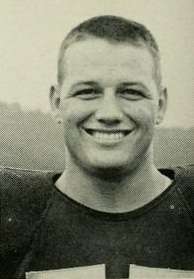
Despite finishing with a modest 6–4 record in 1956, West Virginia won its fourth consecutive SoCon title with a 5–0 record in conference play.[18] The 1957 season resulted in a 7–2–1 record and a 3–0 mark in Southern Conference play. Although the Mountaineers once again compiled an undefeated SoCon record, they were not awarded the conference championship, as VMI earned the title with a 9–0–1 overall record and 6–0 record in SoCon play.[19] In 1958, the Mountaineers had their first losing season in eight years, but their 4–0 record in SoCon play earned them a 5th conference title in six seasons.[20] The 1958 season was the final season that West Virginia would win a conference championship under Lewis's tenure. The Mountaineers finished 3–7 in 1959, losing the final five games of the season by a combined score of 24–140.[21] Lewis resigned as head coach afterward. Despite the program's drop off in success in his final two seasons as coach, Lewis produced 58 victories overall during his tenure at West Virginia, placing him fourth overall in the program's history.[22]
Corum and Carlen era (1960–1969)
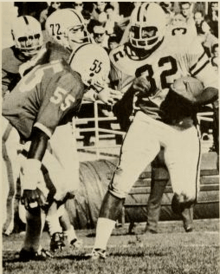
After Lewis's departure, the program hit an all-time low in 1960 under first-year head coach Gene Corum, posting its worst season to date: 0–8–2. The Mountaineers were simply outclassed by their opponents, being outscored 40–259 on the season.[23] The Mountaineers rebounded, however, and by 1962 were back to their winning ways, posting an 8–2 record and 4–0 conference record. Despite their undefeated conference record, once again the SoCon crown eluded the Mountaineers in favor of the VMI Keydets and their 6–0 record in conference play.[24] West Virginia did not have to wait long for its next SoCon title, however, as the program won the title in the 1964 and 1965 seasons consecutively. The Mountaineers finished 7–4 in 1964 and participated in the Liberty Bowl against Utah, West Virginia's first bowl game in 11 years as well as the first major college football bowl game ever played indoors and to be broadcast nationwide in the United States.[25] Corum's tenure ended thereafter, posting a 29–30–2 record over his six seasons as head coach. Corum's legacy went well beyond wins and losses, however, as he integrated WVU football in 1963 with the program's first African-American recruits in Roger Alford and Dick Leftridge.[26]
Following the 1965 season, Jim Carlen took over for Corum as head coach. After a 3–5–2 finish in 1966, Carlen guided the Mountaineers to their 8th and final SoCon championship in 1967.[27] West Virginia left the Southern Conference thereafter, participating as an independent until 1991. Carlen's Mountaineers would produce subsequent winning seasons in 1968 and 1969, posting records of 7–3 and 10–1, respectively. The 1969 edition of the Mountaineers was the most successful West Virginia team since the 1922 season.[4] Not only did the Mountaineers win 10 games, but they earned their first bowl game victory since 1948 with a Peach Bowl victory over No. 19 South Carolina, as well as a No. 18 final ranking in the Coaches Poll. The dynamic rushing tandem of running back Bob Gresham (1,155 yards and 9 touchdowns) and fullback Jim Braxton (843 yards, 12 touchdowns) led the Mountaineers.[28] Gresham became the second Mountaineer to ever rush for more than 1,000 yards (Garrett Ford, Sr. was the first with 1,068 yards in 1966).[29] At the conclusion of the 1969 season, Carlen departed West Virginia for Texas Tech. The Mountaineers responded by hiring Bobby Bowden.
Bobby Bowden era (1970–1975)
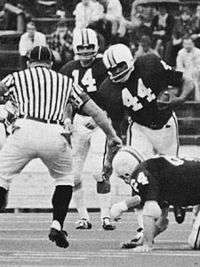
It appeared that the Bobby Bowden era of Mountaineer football could not have begun more smoothly early in the 1970 season, or so it seemed. The Mountaineers were 4–1 to start the season and led arch rival Pitt 35–8 at halftime in week six.[30] What transpired was one of the most infamous collapses in Backyard Brawl and West Virginia football history. The Mountaineers surrendered 28 unanswered points, losing to the Panthers 36–35 and leading Bowden to remark that he had "embarrassed the whole state of West Virginia" in the process.[31] Despite the disappointment of the Pitt defeat, West Virginia went on to finish the 1970 season with an 8–3 record. Fullback Jim Braxton and linebacker Dale Farley earned All-American honors.
The Mountaineers continued their winning ways under Bowden in 1971 and 1972, posting records of 7–4 and 8–4 respectively. The 1972 West Virginia team earned the program's first trip back to a bowl game in three years, participating once again in the Peach Bowl against North Carolina State. The season also witnessed the offensive prowess of running back Kerry Marbury and wide receiver Danny Buggs. Marbury ran for 16 touchdowns in 1972, a record that remained unbroken until 2002.[32] Buggs recorded 35 receptions for 791 yards and eight touchdowns, ran for four touchdowns, and returned two punts for touchdowns to amass 14 total touchdowns.[33]
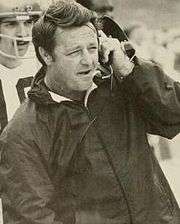
The 1973 and 1974 seasons, however, were not successful campaigns for the Mountaineers, as they finished with records of 6–5 and 4–7. Despite the disappointment of those seasons, Danny Buggs earned All-American status for his contributions in both campaigns. The 1975 season was successful as the Mountaineers compiled a 9–3 record, a 13–10 Peach Bowl victory over North Carolina State, and a final ranking of No. 17 in the Coaches Poll and #20 in the AP Poll. Additionally, the Mountaineers upset the No. 20 Pitt Panthers 17–14 on a game-winning field goal in the closing seconds in yet another memorable chapter of the Backyard Brawl. Bowden later described the victory as one of the most exciting ones of his coaching career.[31] Following the 1975 season, Bowden left WVU to become the head coach at Florida State, where he would become the second winningest coach in NCAA Division I-A/FBS history. In just six seasons with the Mountaineers, Bowden produced a 42–26 record, good for fifth all-time in the program.[22] Bowden's departure not only signaled the end of his tenure at West Virginia, but to the end of WVU's winning ways in the 1970s.
Frank Cignetti era (1976–1979)
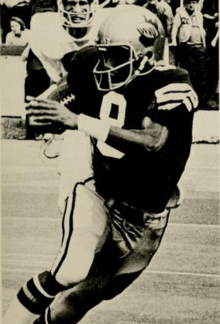
Under the direction of Frank Cignetti, the Mountaineers endured four consecutive losing seasons. West Virginia completed the 1976 season with a 5–6 record, losing four of its final six games. The disappointment of 1976 was realized again the following season, as the Mountaineers posted another 5–6 finish in 1977. After a promising 4–1 start to the season, including an upset road victory over No. 11 Maryland, WVU lost five of its final six games. The Mountaineers finished 2–9 in 1978, being outscored 364–167. It was later revealed that Cignetti had suffered from a rare form of cancer during the season, nearly losing his life on the operating table during a procedure to remove his spleen in the winter of 1978.[34] The 1979 season was Cignetti's final with the program. The Mountaineers produced another 5–6 finish, losing their first three games and later dropping three out of their final four games.
Despite the program's losing seasons during Cignetti's tenure, Cignetti managed to land prized recruit and future Consensus All-American linebacker Darryl Talley, as well as standout quarterback and future Athletic Director Oliver Luck and running back Robert Alexander. Cignetti's coaching staffs also consisted of some of the best coaches in college football, including Nick Saban, Joe Pendry and Rick Trickett (who, along with Rich Rodriguez, was later credited as an innovator in utilizing the zone blocking scheme in conjunction with the run-based spread offense at WVU).[34] However, with a 17–27 record during his four years with the program, and in having to follow in the footsteps of the great Bobby Bowden (who later became the second all-time leader in victories amongst NCAA FBS coaches), Cignetti's legacy is one of the most conflicted in the program's history.[35]
Nehlen's early years (1980–1984)

In the wake of Frank Cignetti's firing, the West Virginia Athletic Department determined that a full rebuild was in order.[36] On December 10, 1979, West Virginia introduced Don Nehlen as its new head coach, the 30th coach in the program's history. Coinciding with Nehlen's hire was the construction of the second incarnation of Mountaineer Field, the program's current home stadium.[36] Nehlen brought several changes to the Mountaineer football program, including a new logo and color scheme that remains in use to this day.[36] The result was consistency and success for the program during his two-decade tenure at West Virginia. After a 6–6 campaign in 1980, Nehlen's 1981 Mountaineer team produced the first of 15 winning seasons under his direction. It also marked the first of three consecutive nine-win seasons and four consecutive bowl game appearances for the Mountaineers. Led by senior quarterback Oliver Luck's 2,448 yards passing and 16 touchdowns, the 1981 team posted a 9–3 record and earned a trip back to the Peach Bowl, where they defeated the Florida Gators 26–6. WVU also finished ranked in the polls for the first time since 1975, coming in at No. 17 and No. 18 in the AP and Coaches Polls, respectively.
The 1982 Mountaineers experienced similar success. Sparked by their come-from-behind upset victory over No. 9 Oklahoma to open the season, the Mountaineers finished with a 9–2 record, remaining ranked in the AP poll throughout the season en route to a Gator Bowl berth with Bobby Bowden and Florida State. Despite its Gator Bowl loss, West Virginia once again finished the season 9–3 and ranked 19th in both final polls. The team also produced the program's first Consensus All-American since 1955 in senior linebacker Darryl Talley. The Mountaineers won their first six games at the outset of the 1983 season, attaining a No. 4 ranking in the AP Poll. With a 41–23 upset loss to 1983 in week 8, however, West Virginia's hopes of an undefeated season collapsed. WVU lost three of its final five regular season games before defeating Kentucky in the Hall of Fame Classic to finish the season at 9–3. It was the third consecutive season for WVU to finish ranked, coming in at No. 16 in both the AP and Coaches Polls. Quarterback Jeff Hostetler led the offensive attack with 2,345 yards passing and 16 touchdowns, while Kicker Paul Woodside received All-American honors in converting 21 of 25 field goal attempts and all 37 of his extra point attempts en route to a team-leading 100 points.[37]
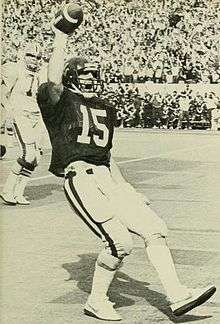
Although the 1984 season had all off the makings of a memorable one for West Virginia, the Mountaineers experienced another letdown. WVU started the season with a 7–1 record, posting an upset victory over No. 4 Boston College and its first victory over Penn State in 25 meetings along the way. The Mountaineers were upset in each of their final three regular season games, however, losing to Virginia, Rutgers and Temple. WVU rebounded to defeat Texas Christian in the Bluebonnet Bowl, finishing the season at 8–4 with a No. 21 ranking in the final Coaches poll. The Mountaineers also produced three All-Americans in return specialist Willie Drewrey, kicker Paul Woodside, and tight end Rob Bennett.[38]
Pursuit of a national championship (1985–1989)
After four consecutive seasons of bowl berths and finishes in at least one of the polls, West Virginia went on a two-year drought in 1985 and 1986, finishing those seasons with records of 7–3–1 and 4–7 (Nehlen's first of only four losing seasons) respectively. The shortcomings of those seasons came to a head in 1987, where the Mountaineers endured a season of growing pains and near-misses. Despite a 1–3 start, West Virginia rallied to finish the regular season at 6–5 with four of its five losses coming by deficits of 5 points or less. Freshman quarterback Major Harris led the way for the Mountaineers, compiling 16 total touchdowns and providing glimpses of what was to come in his illustrious collegiate career.[39] The season culminated in a 35–33 loss to No. 11 Oklahoma State in the Sun Bowl, a game in which the Mountaineers led 24–14 at halftime and lost on a failed two-point conversion attempt with 1:13 remaining.[40]
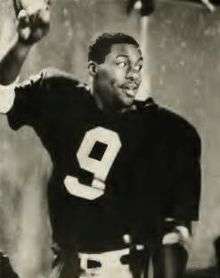
The 1988 edition of the Mountaineers achieved an undefeated regular season, compiling 11 wins for the first time in its history. The success of the regular season culminated in West Virginia's first and only trip to a National Championship Game in its history, where the No. 3 Mountaineers met No. 1 Notre Dame in the Fiesta Bowl. Notre Dame went on to win 34–21 and claimed the national championship. West Virginia finished the 1988 campaign ranked No. 5 in both the AP and Coaches Polls. Major Harris compiled 610 yards rushing, 1,915 yards passing, and 20 total touchdowns on the season.[41]
Coming off of its first ever 11-win season and with junior Major Harris returning to lead a potent offense, West Virginia entered the 1989 season with high expectations and a No. 17 ranking in the AP Poll. The Mountaineers raced to a 4–0 record and to No. 9 in the AP Poll. In Week 5 against No. 10 Pitt, however, West Virginia fell victim to another memorable collapse in the Backyard Brawl. Trailing 31–9 in the 4th quarter, Pitt scored 22 unanswered points and kicked a game-tying field goal as time expired to force a 31–31 tie. The Mountaineers suffered another defeat the following week with a 12–10 home loss to Virginia Tech, followed by a 19–9 loss to No. 16 Penn State in State College. Despite those defeats, WVU finished the regular season at 8–2–1, a No. 17 ranking in the AP Poll, and a trip to the Gator Bowl to face No. 14 Clemson. The Mountaineers lost 27–7 and finished the season at 8–3–1 with a No. 21 ranking in the final AP Poll. The 1990 season, West Virginia's final as a NCAA Division I-A Independent, coincided with a 4–7 finish.
End of independence (1991–1997)
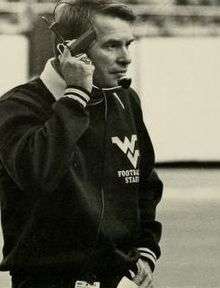
West Virginia entered the 1991 season as new members of the Big East in what became a 20-year affiliation with the conference. After finishes of 6–5 in 1991 and 5–4–2 in 1992, the Mountaineers returned to ranks of the college football elite in the 1993 season. For the second time in six seasons, West Virginia produced an undefeated, 11-win regular season in 1993. The Mountaineers engineered several close victories, beginning with a 36–34 upset of No. 17 Louisville at home in Morgantown. In its final two regular season games, WVU twice erased 4th quarter deficits to defeat No. 4 Miami and No. 11 Boston College. Despite finishing the regular season undefeated and ranked No. 2 in the Coaches Poll and No. 3 in the AP Poll, West Virginia was not selected to play in the Orange Bowl for a possible national championship. The Bowl Coalition system, designed to place the top two ranked teams in a bowl to determine the National Champion, slotted the Mountaineers at No. 3 behind 11–1 Florida State. The Seminoles were selected to play No. 1 Nebraska in the Orange Bowl for the national championship, while West Virginia settled for a Sugar Bowl berth against SEC Champion Florida. The Gators routed the Mountaineers 41–7, denying West Virginia its perfect season. WVU finished the season at 11–1, ranked No. 6 in the Coaches Poll and No. 7 in the AP Poll. Robert Walker amassed a then-school record 1,250 rushing yards, along with 11 touchdowns on the season.[42]
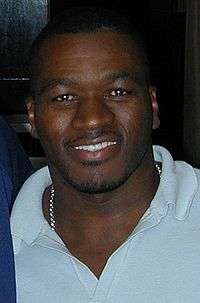
The 1993 season was WVU's final season with double-digit victories during Nehlen's tenure as subsequent Mountaineer teams failed to recapture that level of success. After posting a 7–6 record in 1994 and a 5–6 mark in 1995, the 1996 Mountaineers showed promise of returning the program to national prominence. West Virginia began the 1996 season with a 7–0 record, only to lose three of its final four regular season games en route to an 8–3 record and a 20–13 defeat in the Gator Bowl at the hands of No. 12 North Carolina to finish 8–4. The Mountaineers put together another strong start in 1997, taking a 7–2 record into the final two weeks of the season. Once again, the Mountaineers faltered as they lost 21–14 at Notre Dame and 41–38 in triple overtime to a 5–5 Pitt team to finish the regular season at 7–4. The late season collapse culminated in another bowl game defeat, this time to Georgia Tech in the Carquest Bowl. Despite the disappointing conclusion to the season, quarterback Marc Bulger emerged as a capable leader throwing for 2,465 yards and 14 touchdowns. Running back Amos Zereoué shattered Robert Walker's rushing record with 1,589 yards, and his 18 rushing touchdowns are the second most in a single season at WVU.[43]
End of the Nehlen era (1998–2000)
The 1998 season brought high expectations for the Mountaineers, as WVU entered the season ranked No. 11 in the AP Poll. Despite dropping its opening game to No. 1 Ohio State,[44] West Virginia rebounded to win its next four games and went on to finish the season with an 8–3 record and 5–2 mark in Big East conference play. The Mountaineers failed to attain nine wins, however, as they lost their 8th consecutive bowl game in the Insight.com Bowl to Missouri. Bulger set two WVU records with 3,607 yards passing and 31 touchdown passes, while Zereoué amassed 1,462 yards rushing and 13 touchdowns in his final season as a Mountaineer. Receivers Shawn Foreman and David Saunders finished with eight touchdown receptions each.[45] After a 4–7 finish in 1999, Don Nehlen's final season with the Mountaineers in 2000 culminated in a 7–5 record with a victory in the Music City Bowl over Ole Miss, ending West Virginia's streak of futility in bowl games.
Overall, Nehlen posted a 149–93–4 record during his tenure at West Virginia, making him both the longest-serving and most successful head coach in Mountaineer history.[22] While his coaching tenure contained numerous successes, Nehlen's time at WVU also included its share of shortcomings as his Mountaineer teams often struggled against ranked opponents and in bowl games.[Note 1] However, as the man responsible for shaping the Mountaineer football program and bringing it to national relevancy in his 21 seasons in Morgantown, Nehlen was inducted into the College Football Hall of Fame in 2005. Most importantly, his tenure laid the foundation for the program's most successful and prominent era.[46]
Transition from Nehlen to Rodriguez (2001–2004)

After Nehlen's retirement, WVU named Rich Rodriguez as its first new head coach in 20 years. Rodriguez's tenure began ignominiously, as the 2001 edition of the Mountaineers finished 3–8, its worst record since 1978. The failures of 2001, however, set the stage for the emergence of the most successful era in Mountaineer football history.[4]
The 2002 season represented the biggest single-season turnaround in program history. Despite a 5–3 record through the season's first eight games, the Mountaineers reeled off four consecutive victories, including upset road wins over then-ranked rivals Virginia Tech (No. 13) and Pitt (No. 17). West Virginia finished the regular season at 9–3 overall, with a 6–1 conference record for second place in the Big East, and a berth in the Continental Tire Bowl with Virginia. Despite losing its bowl game, West Virginia finished with a 9–4 record and was ranked in both the final Coaches (No. 20) and AP (No. 25) polls for the first time since 1993. The momentum generated from the 2002 campaign was short-lived as the Mountaineers stumbled to a 1–4 record early in the 2003 season. In similar fashion to the previous season, West Virginia rebounded and recorded seven wins in a row, including upsets of No. 3 Virginia Tech and No. 16 Pitt. The Mountaineers ended the regular season at 8–4 with a 6–1 conference mark, earning them a share of their first Big East title since 1993. West Virginia earned a trip to the Gator Bowl for a rematch with rival Maryland. The result for the Mountaineers was a near duplicate of their 34–7 defeat to the Terrapins earlier in the season, as they fell 41–7 and finished the season 8–5.
In contrast to 2002 and 2003, the 2004 season may best be remembered for what the Mountaineers failed to accomplish. West Virginia, ranked No. 10 in the AP Poll to begin the season, carried an 8–1 record through its first nine games. The Mountaineers collapsed in the final two games of the regular season, however, losing to No. 21 Boston College and to Pitt. West Virginia squandered its opportunity to win the Big East outright, leading to a four-way tie for first place and the BCS Fiesta Bowl nomination going to Pitt by tiebreaker. The disappointing season drew to a close with 30–18 loss to Florida State in the Gator Bowl, giving WVU an 8–4 record.[47]
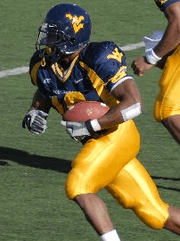
WVU at its height in the Big East (2005–2007)
The 2005 season was a noteworthy one for the Mountaineers. After a 5–1 (albeit offensively sluggish) start to the season, the Mountaineers came alive in Week 7 against No. 19 Louisville.[48] Quarterback Pat White and running back Steve Slaton helped to erase a 24–7 4th quarter deficit en route to a thrilling 46–44 triple overtime victory.[49] From that point forward, the Mountaineers outscored their opponents 156–39 en route to a 10–1 finish and a 7–0 record in conference play for their second outright Big East championship. The Mountaineers also earned their first ever BCS bowl game berth, facing No. 8 Georgia in the Sugar Bowl. West Virginia scored 21 points in the 1st quarter, holding on for a 38–35 upset victory.[50] The Mountaineers finished the 2005 season with their third 11-win season and achieved rankings of No. 5 and No. 6 in the AP and Coaches Polls, respectively.
The Mountaineers once again posted 11 wins in the 2006 season, narrowly missing out on another Big East championship after losses to Louisville and South Florida.[51] West Virginia remained ranked in the top 15 in both polls throughout the season, earning another New Year's Day bowl game as they met Georgia Tech in the Gator Bowl. The Mountaineers came away with another 38–35 victory, winning consecutive bowl games for the first time since the 1983 and 1984 seasons. Additionally, center Dan Mozes and running back Steve Slaton earned Consensus All-American honors. Slaton's 1,744 yards rushing set the WVU single-season rushing record.[52]
The 2007 season may well be regarded as the most infamous season in West Virginia football history.[53] The Mountaineers attained a preseason ranking of No. 3 and had national championship aspirations. WVU raced to a 10–1 record, including a 66–21 victory over UConn to secure its fifth Big East title and its second BCS bowl appearance. The Mountaineers rose to as high as No. 2 in the AP Poll and No. 1 in the Coaches Poll, needing only a victory at home over a 4–7, 28-point underdog Pitt team in the 100th installment of the Backyard Brawl to secure its second ever National Championship Game appearance. That victory did not come, as the Mountaineers suffered a devastating 13–9 defeat.[54]
Bill Stewart era (2007–2011)
– Bill Stewart's locker room speech prior to the 2008 Fiesta Bowl.[55]
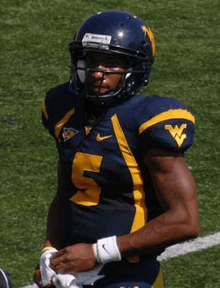
The fallout of the Pitt defeat reached beyond national championship implications for the program, as it culminated in the departure of Rich Rodriguez to Michigan.[56] Rodriguez left prior to West Virginia's meeting with No. 3 Oklahoma in the Fiesta Bowl. The Mountaineers rebounded, posting a 48–28 victory over the heavily favored Sooners. Long-time assistant coach Bill Stewart, named as interim head coach for the game, received a five-year contract to become West Virginia's 32nd head coach.[57] The Mountaineers concluded the 2007 season with an 11–2 record and were ranked at No. 6 in both of the final AP and Coaches Polls.
The Mountaineers transitioned into the Bill Stewart era in the 2008 season. WVU amassed a 9–4 record and a second-place finish in the Big East, closing the season Meineke Car Care Bowl victory over North Carolina and a No. 23 ranking in the AP Poll. The bowl victory was West Virginia's fourth in a row, giving Pat White a postseason record of 4–0 as a starting quarterback.[58] During Week 13 of the 2008 season, White set the NCAA rushing yardage record for quarterbacks with a 200-yard performance in a 35–21 win over Louisville.[59]
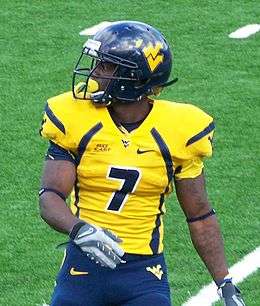
The 2009 season culminated in another nine-win campaign and second-place finish in the Big East for the Mountaineers. WVU ended its two-year losing streak in the Backyard Brawl with an upset victory over No. 8 Pitt. West Virginia's season concluded with a loss in the Gator Bowl to Florida State in Bobby Bowden's final game as a head coach.[60] The 2010 season brought the program its third consecutive nine-win season. Nonetheless, the season was ultimately a disappointment for the Mountaineers. Despite assembling arguably the strongest defense in program history (surrendering only 176 total points, an average of 13.5 per game) and having a talented offense, West Virginia struggled with consistency all season.[61] The Mountaineers lost to No. 15 LSU, Syracuse and UConn by a combined 14 points, while the Mountaineer defense did not surrender more than 23 points scored against in a single game throughout the season. WVU's loss to Connecticut in Week 9 came back to haunt the Mountaineers as they lost out on a BCS Bowl bid by virtue of a tiebreaker to the Huskies.
Dana Holgorsen era (2011–2018)

Prior to West Virginia's Champs Sports Bowl match up with North Carolina State, Dana Holgorsen was hired as the "coach-in-waiting," serving as offensive coordinator during the 2011 season and replacing Stewart as head coach in 2012.[62] Nearly six months later, the coach-in-waiting arrangement imploded as Stewart resigned.[63]
The Mountaineers finished the 2011 regular season with a 9–3 record (5–2 in Big East play) and a share of its 7th Big East title.[64] The Mountaineers were the only Big East team ranked in the final BCS standings (No. 23), earning the BCS bid by tiebreaker and an Orange Bowl berth against ACC champion No. 14 Clemson.[65] In its first Orange Bowl appearance, the Mountaineers soundly defeated Clemson 70–33 and set an NCAA record for points scored in a bowl game.[66] The Mountaineers finished the season at 10–3 and ranked No. 17 in the AP Poll and No. 18 in the Coaches Poll.
From 2002–2011, the Mountaineer football program yielded its most prolific era to date, producing a 95–33 record.[4] During that span WVU participated in ten bowl games, finished ranked in at least one of the AP or Coaches Polls on seven occasions, won six Big East Conference titles, and produced three BCS bowl game victories.
In the midst of continued college football conference realignment, WVU joined the Big 12 Conference as of July 1, 2012.[67][68]
Despite starting the 2012 season at 5–0 and climbing into the top 5 in the AP and Coaches Polls, WVU lost six of its final eight games en route to a 7–6 finish. The season culminated in a loss to rival Syracuse in the Pinstripe Bowl.[69]
The 2013 season brought WVU's first losing campaign since 2001. After a 4–5 start and an opportunity to secure bowl eligibility with two victories, WVU faltered in its final three games to finish 4–8.
The Mountaineers rebounded in the 2014 season, posting a 7–6 record against a schedule featuring five opponents ranked in the top 15. WVU raced to a 6–2 start, only to lose four of its final five games. The Mountaineers returned to a bowl game in 2014, losing in the Liberty Bowl. WVU returned to the eight-win plateau in 2015 season, posting a 7–5 record during the regular season and winning the Cactus Bowl.
In the 2016 season, the Mountaineers finished in second place in the Big 12 and finished the season with a 10–3 record, the ninth season in the program's history with at least ten victories. The season culminated in a loss to Miami in the Russell Athletic Bowl. Prior to the conclusion of the regular season, Holgorsen and WVU agreed to a five-year contract extension.
In 2017, WVU finished 7–6. The season concluded with a loss in the Heart of Dallas Bowl. The Mountaineers started the season 7–3, only to lose their final three games after a season-ending hand injury to quarterback Will Grier. The 2018 season saw the Mountaineers start with an 8–1 record, earning top 10 rankings in the polls and in the College Football Playoff. WVU faltered in its final two regular season games, however, and failed to earn a berth in the Big 12 Championship Game. WVU finished 8–4 with a loss in the Camping World Bowl. Soon thereafter, Dana Holgorsen left the program to take the head coaching position at the University of Houston.
Neal Brown era (2019–present)
On January 5, 2019, former Troy head coach Neal Brown was named the 34th head coach of the program.[70] WVU finished the 2019 season with a 5–7 record, failing to qualify for a bowl game for the first time since 2013.
Conference affiliations
- Independent (1891–1924, 1928–1949, 1968–1990)
- West Virginia Intercollegiate Athletic Conference (1925–1927)
- Southern Conference (1950–1967)
- Big East (1991–2011)
- Big 12 Conference (2012–present)
Championships
Conference championships
West Virginia has won or shared a conference championship on 15 occasions, ten outright and five shared, including eight Southern Conference (SoCon) titles and seven Big East Conference titles.[71]
| Year | Coach | Conference | Overall record | Conference record |
|---|---|---|---|---|
| 1953 | Art Lewis | Southern Conference | 8–2 | 4–0 |
| 1954 | Art Lewis | Southern Conference | 8–1 | 3–0 |
| 1955 | Art Lewis | Southern Conference | 8–2 | 4–0 |
| 1956 | Art Lewis | Southern Conference | 6–4 | 5–0 |
| 1958 | Art Lewis | Southern Conference | 4–5–1 | 4–0 |
| 1964 | Gene Corum | Southern Conference | 7–4 | 5–0 |
| 1965 | Gene Corum | Southern Conference | 6–4 | 4–0 |
| 1967 | Jim Carlen | Southern Conference | 5–4–1 | 3–0 |
| 1993 | Don Nehlen | Big East Conference | 11–1 | 7–0 |
| 2003† | Rich Rodriguez | Big East Conference | 8–5 | 6–1 |
| 2004† | Rich Rodriguez | Big East Conference | 8–4 | 4–2 |
| 2005 | Rich Rodriguez | Big East Conference | 11–1 | 7–0 |
| 2007† | Rich Rodriguez | Big East Conference | 11–2 | 5–2 |
| 2010† | Bill Stewart | Big East Conference | 9–4 | 5–2 |
| 2011† | Dana Holgorsen | Big East Conference | 10–3 | 5–2 |
† Co-champion
Regional championships
The ECAC Lambert-Meadowlands Trophy is an annual award given to the best team in the Eastern Region of FBS-level college football. West Virginia has received the award as Eastern Champion on four occasions.
| Season | Coach | Region | Record |
|---|---|---|---|
| 1988 | Don Nehlen | Eastern | 11–1 |
| 1993 | Don Nehlen | Eastern | 11–1 |
| 2007 | Rich Rodriguez | Eastern | 11–2 |
| 2011 | Dana Holgorsen | Eastern | 10–3 |
Bowl games
West Virginia has participated in 37 bowl games throughout its history, compiling a 15–22 record through the 2018 season.[72] The Mountaineers endured a dubious string of post-season futility from 1987 to 2004, losing 11 of 12 bowl games including eight consecutive losses between 1987 and 1998. These are West Virginia's last ten bowl games.
| Season | Bowl | Opponent | Result |
|---|---|---|---|
| 2008 | Meineke Car Care Bowl | North Carolina | W 31–30 |
| 2009 | Gator Bowl | Florida State | L 21–33 |
| 2010 | Champs Sports Bowl | NC State | L 7–23 |
| 2011 | Orange Bowl | Clemson | W 70–33 |
| 2012 | Pinstripe Bowl | Syracuse | L 14–38 |
| 2014 | Liberty Bowl | Texas A&M | L 37–45 |
| 2015 | Cactus Bowl | Arizona State | W 43–42 |
| 2016 | Russell Athletic Bowl | Miami | L 14–31 |
| 2017 | Heart of Dallas Bowl | Utah | L 14–30 |
| 2018 | Camping World Bowl | Syracuse | L 18–34 |
Head coaches
The West Virginia Mountaineers have had 33 head coaches throughout the program's history. With 149 victories, Don Nehlen is first overall in the program's history, followed by Dana Holgorsen (61 wins) and Rich Rodriguez (60).[22]
| Name | Seasons | Record | Pct. |
|---|---|---|---|
| Frederick Lincoln Emory | 1891 | 0–1 | .000 |
| F. William Rane | 1893–94 | 4–3 | .571 |
| Harry McCrory | 1895 | 5–1 | .833 |
| Thomas Trenchard | 1896 | 3–7–2 | .333 |
| George Krebs | 1897 | 5–4–1 | .550 |
| Harry Anderson | 1898 | 6–1 | .857 |
| Louis Yeager | 1899, 1901–02 | 12–9 | .571 |
| John E. Hill | 1900 | 4–3 | .571 |
| Harry E. Trout | 1903 | 7–1 | .875 |
| Anthony Chez | 1904 | 6–3 | .667 |
| Carl Forkum | 1905–1906 | 13–6 | .684 |
| Clarence W. Russell | 1907 | 6–4 | .600 |
| Charles A. Lueder | 1908–1911 | 17–13–3 | .561 |
| William P. Edmunds | 1912 | 6–3 | .667 |
| Edwin Sweetland | 1913 | 3–4–2 | .444 |
| Sol Metzger | 1914–1915 | 10–6–1 | .618 |
| Mont McIntire | 1916–1920 | 24–11–4 | .667 |
| Clarence Spears | 1921–1924 | 30–6–3 | .808 |
| Ira Errett Rodgers | 1925–1930, 1943–1945 | 41–31–8 | .563 |
| Greasy Neale | 1931–1933 | 12–16–3 | .435 |
| Charles Tallman | 1934–1936 | 15–12–2 | .552 |
| Marshall Glenn | 1937–1939 | 14–12–3 | .534 |
| Bill Kern | 1940–1942, 1946–1947 | 24–23–1 | .510 |
| Dudley DeGroot | 1948–1949 | 13–9–1 | .587 |
| Art Lewis | 1950–1959 | 58–38–2 | .602 |
| Gene Corum | 1960–1965 | 29–30–2 | .492 |
| Jim Carlen | 1966–1969 | 25–13–3 | .616 |
| Bobby Bowden | 1970–1975 | 42–26 | .618 |
| Frank Cignetti, Sr. | 1976–1979 | 17–27 | .386 |
| Don Nehlen | 1980–2000 | 149–93–4 | .614 |
| Rich Rodriguez | 2001–2007 | 60–26 | .698 |
| Bill Stewart | 2007–2010 | 28–12 | .700 |
| Dana Holgorsen | 2011–2018 | 61–41 | .598 |
| Neal Brown | 2019–present | 5–7 | .417 |
Rankings
West Virginia has finished a season ranked in at least one of the Associated Press (AP) or Coaches polls on 21 occasions. The Mountaineers have finished ranked amongst the top 10 in college football on five occasions. West Virginia attained its highest-ever ranking in the polls during week 14 of the 2007 season, when they were ranked #1 in the Coaches Poll and #2 in the AP Poll.[73]
The Mountaineers have concluded the regular season ranked in the final rankings of the College Football Playoff (CFP) on two occasions. West Virginia finished the regular season ranked seven times in the final rankings of the Bowl Championship Series (BCS), a predecessor to the CFP. The Bowl Coalition, a predecessor to the CFP and BCS systems, ranked WVU 3rd in its final standings at the conclusion of the 1993 regular season. As of the end of the 2017 season, the Mountaineers were 45–113–2 against opponents ranked in the AP Poll.[74] WVU has been ranked in the AP Poll at some point in 39 of their seasons since the inception of the program.[75]
| WVU Final Rankings | |||||||||||||||||||||||||||||||||||||||||||||||||||||||||||||||||||||||||||||||||||||||||||||||||||||||||||||||||||||||||||||||||||||||||||||||||
|---|---|---|---|---|---|---|---|---|---|---|---|---|---|---|---|---|---|---|---|---|---|---|---|---|---|---|---|---|---|---|---|---|---|---|---|---|---|---|---|---|---|---|---|---|---|---|---|---|---|---|---|---|---|---|---|---|---|---|---|---|---|---|---|---|---|---|---|---|---|---|---|---|---|---|---|---|---|---|---|---|---|---|---|---|---|---|---|---|---|---|---|---|---|---|---|---|---|---|---|---|---|---|---|---|---|---|---|---|---|---|---|---|---|---|---|---|---|---|---|---|---|---|---|---|---|---|---|---|---|---|---|---|---|---|---|---|---|---|---|---|---|---|---|---|---|
|
| ||||||||||||||||||||||||||||||||||||||||||||||||||||||||||||||||||||||||||||||||||||||||||||||||||||||||||||||||||||||||||||||||||||||||||||||||
Facilities
Mountaineer Field
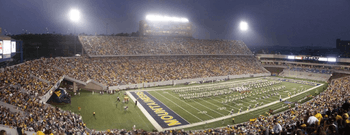
Since 1891, the Mountaineers have played their home games in Morgantown, West Virginia along with neutral-site games at numerous locations throughout West Virginia, most notably in Charleston, Clarksburg, Fairmont, Parkersburg and Wheeling.[4] The construction of Old Mountaineer Field in 1924 gave WVU its first permanent home facility. Located next to Woodburn Hall in what is now considered the Downtown portion of the WVU campus, the first incarnation of Mountaineer Field consisted of a horseshoe-type seating arrangement. The stadium eventually grew in capacity to its peak of 38,000 by 1979. The physical location of the stadium made it impossible for further expansion to take place, however, and led to the relocation of the football program to the new Mountaineer Field in 1980. The old stadium was razed in 1987. At the southwest corner where the stadium once stood, there is a horseshoe-shaped monument commemorating the stadium. From 1924–1979 the Mountaineers played 267 games at Old Mountaineer Field, compiling a 171–82–14 record.[76]
The Mountaineers have played their home games at the second incarnation of Mountaineer Field since 1980. The bowl-shaped stadium is located on the Evansdale section of the WVU campus. Originally constructed with an east–west configuration of the seating areas and a capacity of 50,000, subsequent seating additions at the north and south ends of the facility increased the capacity to over 63,000 by 1986 through the 2003 season. Suites were first introduced to Mountaineer Field in 1994, with 12 suites being constructed in the first row of the press box on the stadium's west end. General admission seating in the north end zone was replaced with 18 suites in 2004 to create the "Touchdown Terrace" section, while four additional suites were added in the south end zone in 2007. The construction of Touchdown Terrace in 2004 brought the stadium's capacity to 60,000, where it currently stands.[77]
As of November 29, 2003, the stadium has been named "Milan Puskar Stadium" in honor of Milan Puskar, the founder of Morgantown-based Mylan Pharmaceuticals, in recognition of his $20 million donation to the University.[78]
Due to Mountaineer Field's capacity and the relatively smaller populations of West Virginia's largest cities, it has been suggested that Morgantown becomes the largest "city" in the state on game days due to the influx of spectators at the stadium.[79][80] Crowds at Mountaineer Field have earned the reputation of being loud and boisterous, creating a hostile atmosphere for opposing teams.[81][82]
The largest crowd to ever attend a game at the stadium was 70,222, set on November 20, 1993.[83]
Milan Puskar Center
Also constructed in 1980 was the "Facilities Building" (now the Milan Puskar Center) to house the program's football offices. Originally located south of Mountaineer Field, in 1985 the facility was connected to the stadium when a 10,000-seat expansion enclosed the South end zone bowl.[84] The 39,000-square-foot facility houses the team's locker room and training facilities, including a 23,000-square-foot weight training facility on the first floor of the complex. The second floor of the Puskar Center houses the offensive and defensive wings for the coaching staffs, the team meeting room, player position rooms, the football staff conference room, and the Reynolds Family Academic Performance Center.[84] Also located on the second floor of the Puskar Center is the Donald J. Brohard Hall of Traditions. Made possible through a gift by WVU alumnus and Datatel, Inc. founder Ken Kendrick, the Hall of Traditions opened in 2006 to honor the history of the WVU football program. The Hall of Traditions houses interactive displays, videos, photos, records and information on the program. The Hall is open to the public on weekdays throughout the year.
The Puskar Center underwent significant renovations in 2012 and 2013, aimed specifically at improving the weight room, the aesthetics of the facility's interior, lounge space for the football players and upgrading the coaches' meeting areas.[85] Further renovation of the Puskar Center in 2015 culminated with the construction of a new team meeting room for the players and coaches. The structure has 162 theater-style chairs to seat an entire football team, as well as support staff and personnel. The room is also utilized for the head coach's weekly news conferences during the season, as well as media interviews with players and other coaches.[86]
Further renovations to the Puskar Center are planned for the future as part of WVU's master plan for athletic facilities.[87]

Practice fields
The Mountaineers utilize two facilities for indoor and outdoor football practices, the Caperton Indoor Practice Facility and the Steve Antoline Family Football Practice Field.
The Caperton facility opened in August 1998. The indoor space is equipped with a 90-yard FieldTurf playing surface with seven yards of safety zone surrounding the entire field. Total length from wall to wall is 105 yards, with more than 75,000 square feet of practice room. Located behind the Caperton facility is the Steve Antoline Family Practice Field, a FieldTurf facility previously consisting of two grass fields. The Antoline facility consists of a full-length 120-yard field along with an adjacent 60-yard field.
Traditions
- See also: WVU Pageantry, WVU Sports Traditions, and WVU Band Traditions

"Take Me Home, Country Roads"
The theme song of West Virginia University, John Denver's "Take Me Home, Country Roads" has been performed at every home football game pregame show since 1972. In 1980, John Denver performed his hit song during pregame festivities to a sold-out crowd at Mountaineer Field. His performance marked the dedication of the second incarnation of Mountaineer Field and the first game for head coach Don Nehlen.[88] After every home win, WVU players and fans link arm-in-arm and sing along to a recording of the song.[89]
Pregame show
Performed by the Pride of West Virginia marching band, the pregame show includes such traditions as the 220-beat per minute run-on introductory drum cadence, the formation of the "Flying WV" logo to the tune of "Fight Mountaineers," and the forming of the state of West Virginia while playing the university fight song "Hail, West Virginia."[90] The band also performs "Take Me Home, Country Roads" as well as Aaron Copland's "Simple Gifts."[90] The fans participate in several cheers during the pregame show, notably chanting "W-V-U" to the roll of the band's drum line prior to the playing of "Fight Mountaineers," as well as chanting "Let's Go Mountaineers" in between playings of "Hail, West Virginia."[91]

Stadium chants
WVU students encompassing the "Mountaineer Maniacs" section and fans alike participate in several chants during WVU home games. The "Let's Go...Mountaineers" chant, with the east end of the stadium shouting "Let's Go..." and the west end responding with "Mountaineers," is the most popular amongst those in attendance.[92] West Virginia fans also participate in the "1st Down" and "3rd Down" cheers. The "1st Down" cheer can be heard at both home and away games prior to the announcement of a Mountaineer first down. Mountaineer fans raise their hands and hold a cheer of "OH!" in unison until the first down call is made by the public address announcer. Following the call, the fans lift their arms up and down three times to a chant of "W-V-U," clap and then signal to the end zone chanting "first down!"[93][94] The "3rd Down" cheer is similar, with Mountaineer fans raising their arms and waving three fingers upon the announcement of "third down" by the public address.
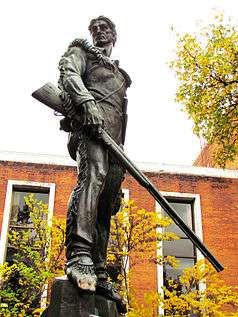
The Mountaineer
WVU incorporated the Mountaineers nickname in 1905 after the coining of West Virginia's state motto, "Mountaineers are Always Free." Prior to 1905, the team was referred to as the "Snakes."[95] The Mountaineer mascot first appeared at WVU sporting events during the 1934–35 school year and has been a fixture ever since. The Mountaineer is selected each year by the Mountain Honorary, composed of members of West Virginia University's senior class.[96] The Mountaineer's costume is tailored to fit each winner, and male Mountaineers customarily grow beards during their tenure to go along with the coonskin cap and rifle, although the beard is not a requirement for the mascot position.[96] The mascot is modeled after the Mountaineer bronze statue located in front of the Mountainlair student union building on the WVU campus. During football games, the Mountaineer mascot will fire his musket upon the team's entrance prior to kickoff, at the conclusion of each quarter and following every score.
Gold Rush, True Blue and Stripe the Stadium
Introduced by head coach Rich Rodriguez during the 2007 season, the "Gold Rush" is an ongoing tradition with WVU fans at Mountaineer Field. Partially inspired by the Penn State "whiteout" tradition, as well as the "black-out" effect created by Louisville Cardinals fans dressed in black during their game against WVU in 2006, Rodriguez encouraged Mountaineer fans to dress entirely in gold for the rematch between WVU and Louisville in 2007.[97] WVU's home schedule has featured a Gold Rush home game in each of its subsequent seasons. Since 2008, West Virginia University has worked in conjunction with the United Way to promote the event, selling gold T-shirts to fans with the proceeds benefiting the WVU United Way Campaign.[98]
In contrast, WVU designates one home game per season as a "True Blue" game where the fans in attendance are encouraged to wear blue throughout the stadium. The Mountaineer players wear their all-blue uniform sets for these particular games.[99]
The fan tradition of "Stripe the Stadium" has been in place since the Mountaineers joined the Big 12 Conference in 2012. Fans are encouraged to wear a designated color for their respective seating section. Fans in even sections of the stadium and students in the lower section of the student section are asked to wear blue. Fans in odd sections and students in the upper section of the student section are asked to wear gold. The result is the stadium appearing to be "striped" in blue and gold".[100]
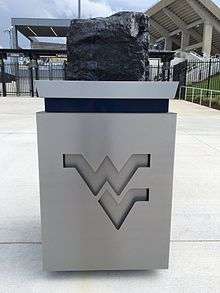
Mountaineer Mantrip
Instituted during the 2011 season by head coach Dana Holgorsen, the Mountaineer Mantrip is a part of West Virginia's gameday traditions and a recognition of the significance of West Virginia's coal industry.[101] The event is named for the shuttle that transports coalminers into and out of an underground mine at the start and end of their shift and takes place at every home game.
The walk begins when the team is dropped off at the corner of the WVU Medical Center and Don Nehlen Drive prior to game time. They are accompanied by the Mountaineer mascot, the Pride of West Virginia Marching Band, and the Mountaineer cheerleaders. WVU students and fans line the path to create a tunnel-like effect for the passing team members.[101] When the team reaches the east end of Mountaineer Field, they stop to rub a 350-pound mounted chunk of coal donated by Alpha Natural Resources from the Upper Big Branch coal mine.[102]
A new feature at the completion of the Mantrip was introduced during the 2018 season. After players and coaches have reached Mountaineer Field and touched the mounted piece of coal, they turn and wave toward the parents and patients inside WVU Medicine Children's Hospital adjacent to Mountaineer Field. Dana Holgorsen added this portion of the festivity having drawn inspiration from the Kinnick Stadium "Wave".[103]
Logos and uniforms

Beginning in 1970, the Mountaineers donned the program's first official logo—the WVU "state outline"—on their helmets through the 1979 season and have reintroduced the logo as part of a "throwback" helmet since 2013.[104] West Virginia used a white helmet with the state outline logo from 1970–72, a gold helmet with the same logo from 1973–78, and reverted to the white helmet and state outline logo in 1979 and again in 2013.
The "Flying WV" is the trademark logo for West Virginia Mountaineer football, adorning the team's helmet and uniform. It debuted in 1980 along with the current gold and blue color scheme as a part of a football uniform redesign by head coach Don Nehlen, and has since become one of the most widely recognized logos in collegiate athletics.[105] In adopting the Flying WV logo on the team's helmets, Nehlen wanted to create a distinct image for the football program that could be easily identified. When Nehlen began his tenure as head coach in 1980, he initially had difficulty in distinguishing between WVU and its opponents while watching game film.[105] The logo itself was created by sports artist John Martin, brother of then-Athletic Director Dick Martin. John Martin's primary inspiration for the logo was the depiction of mountains created with the combination of the state initials 'W' and 'V'.[105][106] The surge in the logo's popularity led to its adoption as the official logo of West Virginia University in 1985.[105]

Since 1980, West Virginia's standard uniform has consisted of a dark blue jersey (home) or a white jersey (away) with gold pants and a dark blue helmet adorned by the gold "Flying WV" logo on both sides.[95] West Virginia's uniform scheme has also included a gold helmet, white helmet, gold jersey, dark blue pants, and white pants at various stages throughout its history. WVU also added a gray uniform and helmet combination to its rotation for the 2012 season.[107]

The Mountaineers wore a Nike Pro Combat uniform or the 2010 season edition of the Backyard Brawl. The uniform was specifically designed to pay tribute to West Virginia's coal mining industry. The jersey and pants consisted of a shade of white accented by a layer of coal dust, along with accents of university gold that referenced canaries utilized in coal mining. The helmet also implemented the coal dust accent, along with a yellow line down the center designed to embody the beam of light emitted by a miner's headlamp.[108] West Virginia also donned the Pro Combat uniforms later that season for the Champs Sports Bowl.
WVU introduced new uniforms for the 2013 season. The helmets, jerseys, and pants featured blue, gold, and white primary color sets, creating 27 different possible uniform combinations. The reintroduction of the gold and white helmets to the uniform scheme marked the first time each have been used since the late 1970s.[109] All of the helmets featured a matte, non-glossy paint finish and the "Flying WV" logo adorned on each side. WVU introduced a white "throwback" helmet during the 2013 season, utilizing the 1970s "state outline" logo.[110] The West Virginia state motto, Montani Semper Liberi, (“Mountaineers are Always Free”), was stitched inside the back collar of all three jerseys. A canary image was stitched inside the front collar, representative of West Virginia's coal mining heritage for their use in testing toxicity levels in the mines. The jerseys had a unique number style exclusive to WVU, featuring sharp points and edges inspired by a miner's pickaxe.[109]
As of the 2019 season and as part of a larger re-branding of all WVU sports teams, the Mountaineers incorporated new Nike Vapor Untouchable football uniforms. The all-gray alternate uniform also returned to the rotation.[111]
Rivalries
Marshall
The Friends of Coal Bowl between West Virginia and the Marshall Thundering Herd has been noncompetitive, as Marshall has never beaten the Mountaineers in 12 meetings. There is considerable doubt for the future of the Friends of Coal Bowl as the final game of the series was played in 2012 and there are no plans to renew the series.[112]
Maryland
The Mountaineers and Maryland Terrapins have met on a semi-annual basis since 1919, recently rekindling a cross-border rivalry that was once the longest continuous non-conference series for these geographical neighbors.[113] The Mountaineers lead the series 28–22–2 through the 2018 season.[114]
Penn State
The series between West Virginia and Penn State has been historically one-sided. The teams met annually from 1947–1992. From 1959 to 1983, Penn State had won 25 consecutive meetings between the two. The series ended in 1992 with Penn State commencing Big Ten Conference play in 1993. On September 19, 2013, the schools announced that they would renew the series with two games in 2023 and 2024.[115] Penn State leads the series 48–9–2 through the 2017 season.[116]
Pitt

In terms of competitiveness, intensity and longevity, the Backyard Brawl with the Pittsburgh Panthers is West Virginia's most fierce and storied rivalry. Separated by only 70 miles, the two universities have competed on a mostly annual basis since 1895 (beginning in 1920 and resuming again in 1943 after World War II). Although Pitt holds a 61–40–3 series lead, more than half of its victories in the Backyard Brawl came prior to 1952 when the Panthers dominated the series 34–9–1. The Mountaineers hold a 26–22–2 edge over the Panthers since 1962 when the series began to interchange annually between Morgantown and Pittsburgh. West Virginia has also won seven of the last ten meetings. Put on hiatus following the 2011 season due to conference realignment, the series will resume with four games running from 2022–2025.
Syracuse
West Virginia also enjoyed a long-standing rivalry with the Syracuse Orange. The schools have competed annually from 1955–2012, with the 1993 addition of the Ben Schwartzwalder Trophy being awarded to the victor. The significance of the trophy resides in the fact that Ben Schwartzwalder was a West Virginia native, former WVU player, and legendary head coach at Syracuse. While Syracuse holds a 33–27 lead in the series, WVU has won eight of the last ten games between the schools. Much like the status of the Backyard Brawl, Syracuse's departure from the Big East for the Atlantic Coast Conference and WVU's joining of the Big 12 Conference casts doubt over the future of the series.[117]
Virginia Tech
The Mountaineers also once enjoyed a fierce rivalry with their Appalachia counterparts, the Virginia Tech Hokies. The schools once competed on an annual basis from 1973 to 2005, doing so as Big East Conference rivals starting in 1991. Beginning in 1997, West Virginia and Virginia Tech competed for the Black Diamond Trophy, symbolizing the Appalachian region's rich coal heritage.[118] While West Virginia held a 28–22–1 advantage in the series, Virginia Tech won nine of the last 12 meetings between the schools. Since the Hokies departed the Big East for the ACC in 2004 and ended the series in 2006, the rivalry has been dormant. The rivalry was renewed with a neutral-site game in 2017, and with a future set of games for the 2021 and 2022 seasons. West Virginia leads the series with Virginia Tech 28–23–1 through the 2017 season.[119]
Louisville
Louisville and West Virginia first met on the football field on September 8, 1984. The Mountaineers won the game by a score of 30–6. The teams met again the following year, with West Virginia prevailing by a score of 52–13 that remains to date as the largest margin of victory in the series. The Cardinals and Mountaineers met four more times between 1986 and 1993, with Louisville notching their first win over the Mountaineers in 1990 by a score of 9–7. The teams didn't meet again until Louisville joined the Big East for the start of the 2005 season. That year, the teams played in one of the most memorable games between the two. West Virginia overcame a 24–7 fourth quarter deficit and defeated Louisville 46–44 in triple overtime. The next year proved to be another classic, as #5 Louisville avenged its tough loss from 2005 with a 44–34 victory over #3 West Virginia on November 2, 2006. Both teams have since departed the Big East conference, and they have no future games scheduled.
Individual awards
Heisman Trophy candidates

West Virginia has produced seven Heisman Trophy candidates. Major Harris is the only Mountaineer to be considered as a finalist for the award, garnering consideration in the 1988 and 1989 seasons.[120][121]
|
|
National award winners and finalists
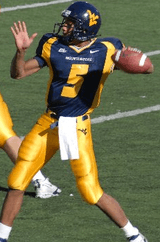
A total of 20 Mountaineer players and coaches have been finalists for numerous college football awards. Don Nehlen and Calvin Magee have won awards as coaches, while Dan Mozes, Pat White, and Tavon Austin have earned awards as players.
| WVU Award Winners and Finalists | |||||||||||||||||||||||||||||||||||||||||||||||||||||||||||||||||||||||||||||||||||||||||||||||||||||||||||||||||||||||||||||||||||||||||||||||||||||||||||||||||||||||||||
|---|---|---|---|---|---|---|---|---|---|---|---|---|---|---|---|---|---|---|---|---|---|---|---|---|---|---|---|---|---|---|---|---|---|---|---|---|---|---|---|---|---|---|---|---|---|---|---|---|---|---|---|---|---|---|---|---|---|---|---|---|---|---|---|---|---|---|---|---|---|---|---|---|---|---|---|---|---|---|---|---|---|---|---|---|---|---|---|---|---|---|---|---|---|---|---|---|---|---|---|---|---|---|---|---|---|---|---|---|---|---|---|---|---|---|---|---|---|---|---|---|---|---|---|---|---|---|---|---|---|---|---|---|---|---|---|---|---|---|---|---|---|---|---|---|---|---|---|---|---|---|---|---|---|---|---|---|---|---|---|---|---|---|---|---|---|---|---|---|---|---|---|
|
|
|
| ||||||||||||||||||||||||||||||||||||||||||||||||||||||||||||||||||||||||||||||||||||||||||||||||||||||||||||||||||||||||||||||||||||||||||||||||||||||||||||||||||||||||
| # – denotes award winners | |||||||||||||||||||||||||||||||||||||||||||||||||||||||||||||||||||||||||||||||||||||||||||||||||||||||||||||||||||||||||||||||||||||||||||||||||||||||||||||||||||||||||||
All-Americans
A total of 39 Mountaineers have been recognized as First-Team All-Americans by various media selectors. Among those selections, 11 have achieved Consensus All-American status. Of those consensus All-Americans, four were unanimous selections.[38]
| WVU First-Team All-Americans | ||||||||||||||||||||||||||||||||||||||||||||||||||||||||||||||||||||||||||||||||||||||||||||||||||||||||||||||||||||||||||||||||||||||||||||||||||||||||||||
|---|---|---|---|---|---|---|---|---|---|---|---|---|---|---|---|---|---|---|---|---|---|---|---|---|---|---|---|---|---|---|---|---|---|---|---|---|---|---|---|---|---|---|---|---|---|---|---|---|---|---|---|---|---|---|---|---|---|---|---|---|---|---|---|---|---|---|---|---|---|---|---|---|---|---|---|---|---|---|---|---|---|---|---|---|---|---|---|---|---|---|---|---|---|---|---|---|---|---|---|---|---|---|---|---|---|---|---|---|---|---|---|---|---|---|---|---|---|---|---|---|---|---|---|---|---|---|---|---|---|---|---|---|---|---|---|---|---|---|---|---|---|---|---|---|---|---|---|---|---|---|---|---|---|---|---|---|
|
|
|
| |||||||||||||||||||||||||||||||||||||||||||||||||||||||||||||||||||||||||||||||||||||||||||||||||||||||||||||||||||||||||||||||||||||||||||||||||||||||||
| * – denotes Consensus All-Americans | ||||||||||||||||||||||||||||||||||||||||||||||||||||||||||||||||||||||||||||||||||||||||||||||||||||||||||||||||||||||||||||||||||||||||||||||||||||||||||||
| # – denotes Unanimous All-Americans | ||||||||||||||||||||||||||||||||||||||||||||||||||||||||||||||||||||||||||||||||||||||||||||||||||||||||||||||||||||||||||||||||||||||||||||||||||||||||||||
Conference award winners
During WVU's 18-season tenure in the Southern Conference, a total of seven Mountaineers were recognized with superlative conference honors. Art Lewis received Coach of the Year distinction on consecutive occasions (1953 & 1954) while Bruce Bosley was named the SoCon Player of the Year and Jacobs Blocking Award winner in 1955.[122] During WVU's 21 seasons in the Big East, a total of 12 Mountaineers were recognized with superlative conference honors. Don Nehlen (1993) and Rich Rodriguez (2003) were unanimous selections for Big East Coach of the Year, while Todd Sauerbrun was the unanimous selection for Big East Special Teams Player of the Year in 1994 and Amos Zereoué was the unanimous selection for Big East Rookie of the Year in 1996. Tavon Austin was WVU's first Big 12 Conference award recipient, garnering Co-Special Teams Player of the Year honors in 2012.
| WVU Conference Award Winners | ||||||||||||||||||||||||||||||||||||||||||||||||||||||||||||||||||||||||||||||||||||||||||||||||||||||||||||||||||||||||||||||||||||||||||||||||||||||||||||||||||||||||
|---|---|---|---|---|---|---|---|---|---|---|---|---|---|---|---|---|---|---|---|---|---|---|---|---|---|---|---|---|---|---|---|---|---|---|---|---|---|---|---|---|---|---|---|---|---|---|---|---|---|---|---|---|---|---|---|---|---|---|---|---|---|---|---|---|---|---|---|---|---|---|---|---|---|---|---|---|---|---|---|---|---|---|---|---|---|---|---|---|---|---|---|---|---|---|---|---|---|---|---|---|---|---|---|---|---|---|---|---|---|---|---|---|---|---|---|---|---|---|---|---|---|---|---|---|---|---|---|---|---|---|---|---|---|---|---|---|---|---|---|---|---|---|---|---|---|---|---|---|---|---|---|---|---|---|---|---|---|---|---|---|---|---|---|---|---|---|---|---|
|
| |||||||||||||||||||||||||||||||||||||||||||||||||||||||||||||||||||||||||||||||||||||||||||||||||||||||||||||||||||||||||||||||||||||||||||||||||||||||||||||||||||||||
All-Conference selections
Southern Conference
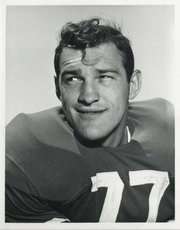
From 1950 to 1967, West Virginia competed in the Southern Conference. During their 18 seasons in the SoCon, a total of 35 Mountaineers were recognized as First-Team All-Southern Conference selections.[122]
|
|
|
|
Big East
The Mountaineers competed in the Big East Conference from 1991 to 2011. During their 21 seasons in the Big East, a total of 61 Mountaineers were recognized as First-Team All-Big East selections. Among those players, Tavon Austin (as a Return Specialist, 2011), Noel Devine, Pat White (2007), Eric Wicks (2006), Adam "Pac-Man" Jones (as a Cornerback, 2004), Grant Wiley (2003), Barrett Green, Canute Curtis, Aaron Beasley (1995), Todd Sauerbrun (1994) and Adrian Murrell (1992) were unanimous selections by the conference.
|
|
|
|
|
Big 12
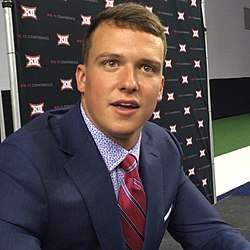
Since joining the Big 12 Conference in 2012, 15 Mountaineers have been recognized as First-Team All-Big 12 selections.
|
|
Awards from within the program
Retired numbers
West Virginia has retired three jersey numbers. It is the highest possible accolade to achieve within the Mountaineer football program.[123]
| No. | Player | Position | Career |
|---|---|---|---|
| 21 | Ira Errett Rodgers | QB / FB | 1915–1917, 1919 |
| 75 | Sam Huff | G / T | 1952–1955 |
| 77 | Bruce Bosley | T | 1952–1955 |
Mountaineer Legends Society
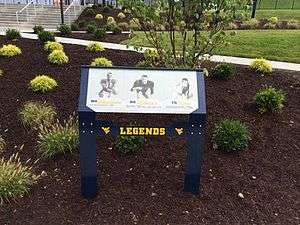
Introduced in 2016, the West Virginia University Mountaineer Legends Society is the second level of recognition for the WVU football program. The Legends Society program replaced the retirement of a jersey number, which had previously served as the second form of recognition. Jersey number retirement remains the highest attainable honor for the WVU football program.
Honors include addition into the team's Legends Park outside of Mountaineer Field and in graphics on column wraps around the stadium's concourse in a "ring of honor" configuration.
To be eligible, a coach, player or administrator must meet the following criteria:
- The individual must have demonstrated consistent and unique national excellence in his collegiate football career, his accomplishments must be significant on an individual and team basis and, in general, must have made a noteworthy contribution to the history of the football program.
- The individual must first be inducted into the WVU Sports Hall of Fame.
- If the individual is a former player or coach, he must accomplish one of a certain set of milestones.[123]
The following individuals have been inducted into the Mountaineer Legends Society for their contributions to the Mountaineer football program:
- Russ Bailey
- Aaron Beasley
- Paul Bischoff
- Bruce Bosley
- Bobby Bowden
- Rich Braham
- Jim Braxton
- Danny Buggs
- Marc Bulger
- Harry Clarke
- Avon Cobourne
- Mike Compton
- Canute Curtis
- Willie Drewrey
- Garrett Ford, Sr.
- Fred Graham
- Major Harris
- Ken Herock
- Jeff Hostetler
- Chuck Howley
- Sam Huff
- Brian Jozwiak
- Oliver Luck
- Walter "Red" Mahan
- Joe Marconi
- Russ Meredith
- Dan Mozes
- Don Nehlen
- Bob Orders
- Bo Orlando
- Ira Errett Rodgers
- Clarence Spears
- Steve Slaton
- Joe Stydahar
- Darryl Talley
- Pat White
- Grant Wiley
- Tom Woodeshick
- Paul Woodside
- Fred Wyant
- Amos Zereoué
WVU Sports Hall of Fame
The West Virginia University Sports Hall of Fame is the first level of recognition for past members of the Mountaineer football program. Former athletes, coaches and administrators are eligible for selection 10 years following their association with WVU athletics. It is the first step of recognition for former players, coaches and administrators.[124] The following individuals have been inducted into the WVU Sports Hall of Fame for their contributions to the Mountaineer football program:
- Roger Alford
- Tommy Allman
- Russ Bailey
- Babe Barna
- Quentin Barnette
- Eddie Bartrug
- Aaron Beasley
- Paul Bischoff
- Bruce Bosley
- Rich Braham
- Jim Braxton
- Bobby Bowden
- Danny Buggs
- Marc Bulger
- Harry Clarke
- Avon Cobourne
- Mike Compton
- Gene Corum
- Carl Crennel
- Canute Curtis
- Dr. John Doyle
- Willie Drewrey
- Ben Dunkerley
- Garnet Edwards
- Garrett Ford, Sr.
- Marshall Glenn
- Jack Gocke
- Fred Graham
- Bob Gresham
- Floyd Hamilton
- Joseph Harrick
- Steve Harrick
- Major Harris
- George "Duke" Henshaw
- Ken Herock
- Charley Hockenberry
- Jerry Holmes
- Jeff Hostetler
- Chuck Howley
- Sam Huff
- James Jett
- Brian Jozwiak
- Bill Karr
- Tom Keane
- Larry Krutko
- Gene Lamone
- Gene Lathey
- E. Roy Lester
- Art "Pappy" Lewis
- Mike Logan
- Oliver Luck
- Walter "Red" Mahan
- John Mallory
- Joe Marconi
- Homer Martin
- Ross McHenry
- Russ Meredith
- Jeff Merrow
- Bobby Moss
- Dan Mozes
- Don Nehlen
- Steve Newberry
- Bob Orders
- Bo Orlando
- Artie Owens
- Tom Pridemore
- Ira Errett Rodgers
- Ben Schwartzwalder
- Charley Seabright
- Mike Sherwood
- Steve Slaton
- Jack Simons
- Clarence Spears
- Joe Stydahar
- Darryl Talley
- Jim Walthall
- Pat White
- Grant Wiley
- Tom Woodeshick
- Paul Woodside
- Fred Wyant
- Donnie Young
- Amos Zereoué
College Football Hall of Fame inductees

The National Football Foundation, overseer of the College Football Hall of Fame, recognizes ten individuals as WVU inductees.[125] Conversely, the Mountaineer football program recognizes 13 individuals as inductees.[126] [Note 2]
| Name | Position | Years at WVU | Year Inducted |
|---|---|---|---|
| Bruce Bosley † | OT | 1952–55 | 1982 |
| Bobby Bowden † | Coach | 1970–75 | 2006 |
| Frank Cignetti, Sr. † | Coach | 1976–79 | 2013 |
| Major Harris † | QB | 1987–89 | 2009 |
| Sam Huff † | LB | 1952–55 | 1980 |
| Greasy Neale † | Coach | 1931–33 | 1967 |
| Don Nehlen † | Coach | 1980–2000 | 2005 |
| Ira Errett Rodgers † | FB | 1915–19 | 1957 |
| Ben Schwartzwalder ‡ | Coach | 1930–32 (player) | 1982 |
| Clarence "Doc" Spears ‡ | G | 1921–24 (coach) | 1982 |
| Joe Stydahar † | OT | 1933–35 | 1972 |
| Darryl Talley † | LB | 1979–82 | 2011 |
| Fielding H. Yost ‡ | Coach | 1895–96 (player) | 1951 |
† – denotes recognition by the National Football Foundation and WVU
‡ – denotes recognition by WVU
Pro Football Hall of Fame inductees
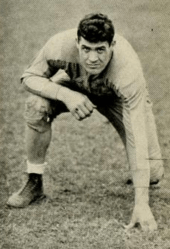
Two Mountaineers hold the distinguished title of Pro Football Hall of Fame inductees. Joe Stydahar, an offensive tackle, was inducted in 1967. Despite Stydahar's impressive collegiate career, Chicago Bears owner/coach George Halas took a chance in selecting the little-known tackle with the Bears' first ever draft selection in the 1936 NFL Draft.[127] Halas's gamble paid off as "Jumbo Joe" produced an illustrious playing career with the Bears, earning four NFL All-Star selections, six All-Pro selections, three NFL championships, and an induction into the NFL's All-Decade Team for the 1930s. Stydahar also served as head coach of the Los Angeles Rams and the Chicago Cardinals, winning the 1951 NFL Championship with the Rams. During his Hall of Fame enshrinement speech, Stydahar thanked his family and friends from his "dear state, West Virginia."[128]
Sam Huff, a linebacker, was inducted in 1982. Originally a third round selection by the New York Giants in the 1956 NFL Draft, Huff played for the Giants from 1956–1963 and later for the Washington Redskins from 1964–1969. Huff's football career, let alone his future in the NFL, almost never came to pass, however. As a junior in high school, WVU head coach Art Lewis came to Huff's town to look at another prospect. Luckily for Huff (and for the Mountaineers), Lewis wound up recruiting Sam instead.[129] Fate intervened once more for Huff at the end of his collegiate career, as Giants scout Al DeRogatis came to Morgantown to look at All-American guard Bruce Bosley. DeRogatis instead discovered Huff, proclaiming that "there's another guard here who will be even greater. His name is Sam Huff."[129] Huff became a five-time Pro Bowl selection, a four-time First-Team All-Pro selection, an inductee in the NFL 1950s All-Decade Team, and was named as one of the 70 Greatest Redskins of all-time. Huff was also recognized as the NFL's Top Linebacker in 1959.[129]
Mountaineers in the National Football League
NFL first round draft selections
WVU has produced a total of 198 NFL Draft selections.[130]
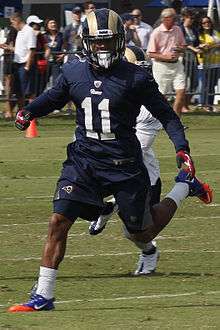
Of those players selected in the draft, 12 Mountaineers have been selected in the first round.
|
|
All-star and Pro Bowl honorees
Among the numerous Mountaineers that have participated in the NFL, a total of 32 have received all-star or Pro Bowl recognition.
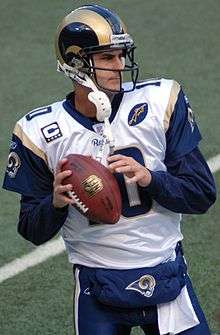
|
|
|
Future non-conference opponents
Announced schedules as of September 11, 2019.[150]
| 2020 | 2021 | 2022 | 2023 | 2024 | 2025 | 2026 | 2027 |
|---|---|---|---|---|---|---|---|
| vs Florida State [Note 3] | at Maryland | at Pittsburgh | at Penn State | Penn State | Pittsburgh | Alabama | at Alabama |
| Eastern Kentucky | LIU | Towson | Duquesne | Albany | at East Carolina | ||
| Maryland | Virginia Tech | at Virginia Tech | Pittsburgh | at Pittsburgh |
Notes
- From 1980–2000, WVU compiled a 14–41–1 record against ranked opponents and a 4–9 record in bowl games, including eight consecutive bowl game defeats between 1987 and 1998.
- The National Football Foundation inducted Spears as a player, and Yost and Schwartzwalder as coaches. Spears did not play for WVU, while Yost and Schwartzwalder never coached for WVU.
- at Mercedes Benz Stadium, Atlanta, GA.
References
- "Milan Puskar Stadium". WVUSports.com. Retrieved August 11, 2020.
- "West Virginia Mountaineers Athletic Identity Logoslick" (PDF). April 15, 2019. Retrieved April 16, 2019.
- DeLassus, David. "West Virginia Historical Data". College Football Data Warehouse. Retrieved September 13, 2014.
- DeVault, Mark. "WVU Season-by-Season". WVU Stats (West Virginia University Department of Intercollegiate Athletics). Retrieved September 25, 2017.
- Bring on the Mountaineers – 100 Years of West Virginia Football (Videotape). West Virginia University Department of Intercollegiate Athletics. 1991. Retrieved December 7, 2011.
- DeVault, Mark. "WVU 1904 Schedule". WVU Stats (West Virginia University Department of Intercollegiate Athletics). Retrieved September 13, 2014.
- "1919 West Virginia Mountaineers Stats". Sports Reference LLC. Retrieved September 13, 2014.
- DeVault, Mark. "WVU 1922 Schedule". WVU Stats (West Virginia University Department of Intercollegiate Athletics). Retrieved September 13, 2014.
- "Glenn Named Grid Coach". The Pittsburgh Press. July 2, 1937. Retrieved January 12, 2012.
- DeVault, Mark. "WVU 1937 Schedule". WVU Stats (West Virginia University Department of Intercollegiate Athletics). Retrieved September 13, 2014.
- "1937 West Virginia Mountaineers Stats". Sports Reference LLC. Retrieved September 13, 2014.
- DeVault, Mark. "WVU 1948 Schedule". WVU Stats (West Virginia University Department of Intercollegiate Athletics). Retrieved September 13, 2014.
- Bring on the Mountaineers – 100 Years of West Virginia Football (Videotape). West Virginia University Department of Intercollegiate Athletics. 1991. Retrieved December 11, 2011.
- DeVault, Mark. "WVU 1952 Schedule". WVU Stats (West Virginia University Department of Intercollegiate Athletics). Retrieved September 13, 2014.
- DeVault, Mark. "WVU 1953 Schedule". WVU Stats (West Virginia University Department of Intercollegiate Athletics). Retrieved September 13, 2014.
- DeVault, Mark. "WVU 1954 Schedule". WVU Stats (West Virginia University Department of Intercollegiate Athletics). Retrieved September 13, 2014.
- DeVault, Mark. "WVU 1955 Schedule". WVU Stats (West Virginia University Department of Intercollegiate Athletics). Retrieved September 13, 2014.
- DeVault, Mark. "WVU 1956 Schedule". WVU Stats (West Virginia University Department of Intercollegiate Athletics). Retrieved September 13, 2014.
- "1957 Southern Conference Year Summary". Sports-Reference.com. Retrieved December 13, 2011.
- DeVault, Mark. "WVU 1958 Schedule". WVU Stats (West Virginia University Department of Intercollegiate Athletics). Retrieved September 13, 2014.
- DeVault, Mark. "WVU 1959 Schedule". WVU Stats (West Virginia University Department of Intercollegiate Athletics). Retrieved September 13, 2014.
- DeVault, Mark. "WVU All-Time Coaches". WVU Stats (West Virginia University Department of Intercollegiate Athletics). Retrieved September 13, 2014.
- DeVault, Mark. "WVU 1960 Schedule". WVU Stats (West Virginia University Department of Intercollegiate Athletics). Retrieved September 13, 2014.
- "1962 Southern Conference Year Summary". Sports-Reference.com. Retrieved September 13, 2014.
- DeVault, Mark. "WVU 1964 Schedule". WVU Stats (West Virginia University Department of Intercollegiate Athletics). Retrieved September 13, 2014.
- Antonik, John (January 5, 2010). "Former football coach Gene Corum was responsible for integrating WVU football". wvutoday.wvu.edu. Retrieved September 13, 2014.
- "1967 Southern Conference Year Summary". Sports-Reference.com. Retrieved December 13, 2011.
- "1969 West Virginia Mountaineers Stats". Sports Reference LLC. Retrieved September 13, 2014.
- DeVault, Mark. "WVU Season Rushing Yards". WVU Stats (West Virginia University Department of Intercollegiate Athletics). Retrieved September 13, 2014.
- DeVault, Mark. "West Virginia at Pitt: Scoring Summary (1970-10-17)". WVU Stats (West Virginia University Department of Intercollegiate Athletics). Retrieved September 13, 2014.
- Bring on the Mountaineers – 100 Years of West Virginia Football (Videotape). West Virginia University Department of Intercollegiate Athletics. 1991. Retrieved December 11, 2011.
- DeVault, Mark. "WVU Season Rushing Touchdowns". WVU Stats (West Virginia University Department of Intercollegiate Athletics). Retrieved September 13, 2014.
- "1972 West Virginia Mountaineers Stats". Sports Reference LLC. Retrieved September 13, 2014.
- Antonik, John (November 8, 2005). "November 8 Notebook". West Virginia University Department of Intercollegiate Athletics. Retrieved December 13, 2011.
- Antonik, John (May 31, 2013). "Former Coach Makes NFF Hall". WVUSports.com (West Virginia University Department of Intercollegiate Athletics). Retrieved September 13, 2014.
- Bring on the Mountaineers – 100 Years of West Virginia Football (Videotape). West Virginia University Department of Intercollegiate Athletics. 1991. Retrieved December 11, 2011.
- "1983 West Virginia Mountaineers Stats". Sports Reference LLC. Retrieved September 13, 2014.
- Fragale, Michael; Montoro, Mike; Swan, Joe, eds. (2012). 2012 WVU Football Guide. Morgantown, WV: West Virginia University Department of Intercollegiate Athletics. p. 153. Retrieved November 3, 2012.
- "1987 West Virginia Mountaineers Stats". Sports Reference LLC. Retrieved September 13, 2014.
- DeVault, Mark. "Oklahoma State vs. West Virginia: Scoring Summary (1987-12-25)". WVU Stats (West Virginia University Department of Intercollegiate Athletics). Retrieved September 13, 2014.
- "1988 West Virginia Mountaineers Stats". Sports Reference LLC. Retrieved September 13, 2014.
- "1993 West Virginia Mountaineers Stats". Sports Reference LLC. Retrieved September 13, 2014.
- "1997 West Virginia Mountaineers Stats". Sports Reference LLC. Retrieved September 13, 2014.
- Antonik, John (July 8, 2010). "30 Most Unforgettable Games – No. 23: Ohio State, 1998". West Virginia University Department of Intercollegiate Athletics. Archived from the original on July 29, 2013. Retrieved September 25, 2017.
- "1998 West Virginia Mountaineers Stats". Sports Reference LLC. Retrieved September 13, 2014.
- Casazza, Mike (2012). Waiting for the Fall: A Decade of Dreams, Drama and West Virginia University Football. Smashwords. p. 8. ISBN 978-0985200909.
- Casazza (2012), p. 31–36.
- Casazza (2012), p. 39–42.
- Finder, Chuck (October 31, 2006). "West Virginia vs. Louisville: '05 game films provide thrill and chills". Pittsburgh Post-Gazette. Retrieved December 6, 2011.
- Casazza (2012), p. 42–43.
- Casazza (2012), p. 48–51.
- DeVault, Mark. "WVU Player Season Records: Rushing Yards". WVU Stats (West Virginia University Department of Intercollegiate Athletics). Retrieved September 14, 2014.
- Casazza (2012), p. 57–87.
- "Pittsburgh Panthers vs. West Virginia Mountaineers – Box Score – December 1, 2007". ESPN.com. Retrieved December 7, 2011.
- Casazza (2012), p. 89.
- "Rodriguez leaving West Virginia to coach Michigan". ESPN.com. December 17, 2007. Retrieved December 7, 2011.
- ESPN.com news services (January 3, 2008). "In Stewart, WVU's successor to Rodriguez right under their nose". ESPN.com. Retrieved December 7, 2011.
- "Top Ten Greatest Mountaineers". Athlon Sports. Retrieved May 18, 2012.
- "White sets NCAA QB rushing mark with 4,292 career yds; WVU tops Louisville". ESPN.com. Associated Press. November 22, 2008. Retrieved December 7, 2011.
- Casazza (2012), p. 112–114.
- Casazza (2012), p. 121–123
- "Bill Stewart out, Dana Holgorsen in as West Virginia Mountaineers football coach". ESPN.com News Services. June 11, 2011. Retrieved December 7, 2011.
- "Bill Stewart out, Dana Holgorsen in as West Virginia Mountaineers football coach". ESPN.com. June 11, 2011. Retrieved September 14, 2014.
- Adelson, Andrea (December 6, 2011). "Wrapping up the Big East regular season". ESPN.com. Retrieved December 14, 2011.
- "West Virginia Mountaineers, Clemson Tigers to meet in Orange Bowl". ESPN.com. Associated Press. December 5, 2011. Retrieved December 14, 2011.
- "West Virginia Mountaineers vs. Clemson Tigers – Recap". ESPN.com. Associated Press. January 4, 2012. Retrieved January 4, 2012.
- "West Virginia University To Join Big 12 Conference". Big12Sports.com (Big 12 Conference). October 28, 2011. Retrieved December 13, 2011.
- Dosh, Kristi. "Breaking down WVU, Big East settlement". ESPN.com. Retrieved September 14, 2014.
- Casazza, Mike (January 3, 2013). "In a word, 2012 team was weak". Charleston Daily Mail. Retrieved September 14, 2014.
- "2018 WVU Football Guide". Retrieved February 1, 2019.
- DeLassus, David. "West Virginia Championships". College Football Data Warehouse. Retrieved September 13, 2014.
- https://www.sports-reference.com/cfb/schools/west-virginia/bowls.html
- "2007 NCAA College Football Polls and Rankings for Week 14". ESPN. Retrieved January 21, 2012.
- "2017 WVU Football Media Guide", p. 171-172.
- "2017 WVU Football Media Guide", p. 171-174.
- DeVault, Mark. "Site: Old Mountaineer Field". WVU Stats (West Virginia University Department of Intercollegiate Athletics). Retrieved September 14, 2014.
- "Milan Puskar Stadium". West Virginia University Department of Intercollegiate Athletics. Retrieved August 18, 2018.
- "WVU names stadium after Puskar". Pittsburgh Business Times. November 24, 2003. Retrieved January 21, 2012.
- "Sporting Life". Greater Morgantown Convention and Visitors Bureau. Retrieved July 21, 2013.
- Kornacki, Steve (October 27, 2011). "Why all of West Virginia now hates Mitch McConnell". Salon. Retrieved May 30, 2012.
- Casazza, Mike (September 15, 2014). "Sooners preparing for 'disrespectful' fans". Charleston Daily Mail. Retrieved September 17, 2014.
- Prewitt, Alex (September 18, 2012). "As Terps prepare to enter noisy Mountaineer Field, confidence in Perry Hills remains constant". Washington Post. Retrieved September 17, 2014.
- Morris, III, Charles W. (October 20, 2010). "e-WV | Mountaineer Field". The West Virginia Encyclopedia. Retrieved August 5, 2013.
- "Milan Puskar Center". West Virginia University Department of Intercollegiate Athletics. Retrieved September 25, 2017.
- Casazza, Mike (August 5, 2013). "Long read: Dana Holgorsen's tour de force". Charleston Daily Mail. Retrieved September 14, 2014.
- "WVU Football's New Team Room". West Virginia University Department of Intercollegiate Athletics. March 14, 2015. Retrieved August 16, 2018.
- "WVU Master Plan - Puskar Center". West Virginia University Department of Intercollegiate Athletics. August 1, 2018. Retrieved August 14, 2018.
- "Country Roads". West Virginia University Alumni Association. Retrieved August 20, 2018.
- "WVU/Baylor End of Game Country Roads". YouTube. September 30, 2012. Retrieved October 2, 2012.
- ""Pride of West Virginia" Mountaineer Marching Band – 2014 Handbook". West Virginia University Mountaineer Marching Band. Retrieved September 14, 2014.
- "2011 LSU at WVU Pregame – Hail, West Virginia". YouTube. Retrieved May 27, 2012.
- "Let's Go Mountaineers at WVU vs. LSU". YouTube. September 25, 2011. Retrieved January 14, 2012.
- "Fight Songs and Chants". West Virginia University Department of Intercollegiate Athletics. Retrieved September 25, 2017.
- "First Down Cheer". West Virginia University Alumni Association. Retrieved January 15, 2012.
- "ESPN College Football Encyclopedia: West Virginia". ESPN.com. December 26, 2005. Retrieved December 13, 2011.
- "Mountaineer Mascot". WVU Alumni Association. Retrieved February 6, 2012.
- Herzel, Bob (November 1, 2007). "'Gold rush' fits WVU". Times West Virginian. Retrieved September 14, 2014.
- "United Way – Gold Rush". West Virginia University. Retrieved June 12, 2012.
- "West Virginia Athletics - Game Promotions Announced". West Virginia University Department of Intercollegiate Athletics. Retrieved November 7, 2017.
- "West Virginia Athletics - Stripe the Stadium". West Virginia University Department of Intercollegiate Athletics. Retrieved November 7, 2017.
- "Mountaineer Mantrip". West Virginia University Department of Intercollegiate Athletics. Retrieved September 25, 2017.
- Marra, Amber (September 1, 2011). "Fans, players participate in first Mountaineer Mantrip". Charleston Daily Mail. Retrieved September 14, 2014.
- "United Bank Playbook, Plus a New Ritual". West Virginia University Department of Intercollegiate Athletics. September 12, 2018. Retrieved September 12, 2018.
- "NationalChamps.net Helmet Project". NationalChamps.net. Retrieved August 24, 2015.
- Stump, Jake (2012). "The Legend of the Flying WV". West Virginia University Alumni Magazine (Spring). Retrieved September 14, 2014.
- "The Flying WV". West Virginia University. Retrieved December 23, 2012.
- Patterson, Chip (June 28, 2012). "West Virginia officially reveals all-gray alternate uniforms". CBSSports.com. Retrieved June 29, 2012.
- Hudson, Ryan. "West Virginia And Pittsburgh Debut Their Nike Pro Combat Uniforms". SB Nation. Retrieved May 25, 2012.
- "PHOTOS: WVU Football's New Uniforms". West Virginia Illustrated. April 20, 2013. Retrieved September 25, 2017.
- Fornelli, Tom. "PHOTOS: West Virginia's throwback helmets". CBSSports.com. Retrieved February 1, 2014.
- Bragg, Tom. "WVU football: Mountaineers unveil new uniforms at Gold-Blue Game". Charleston Gazette-Mail. Retrieved April 16, 2019.
- Butta, Jim (August 31, 2011). "Marshall-WVU has no future". Parkersburg News and Sentinel. Retrieved December 26, 2011.
- Prisbell, Eric (October 27, 2011). "Maryland-West Virginia football rivalry still a hot one, even with new coaches". Washington Post. Retrieved January 13, 2012.
- http://www.winsipedia.com/west-virginia/vs/maryland
- "WVU, Penn State to renew football series". The Journal. September 19, 2013. Retrieved September 19, 2013.
- http://www.winsipedia.com/west-virginia/vs/penn-state
- "Is the Orange's rivalry with West Virginia a thing of the past?". The Post-Standard. October 27, 2011. Retrieved January 13, 2012.
- "Black Diamond Trophy". Hokie Sports (Virginia Polytechnic Institute and State University Athletics). Retrieved January 13, 2012.
- http://www.winsipedia.com/west-virginia/vs/virginia-tech
- "Today's the Day for the Heisman". Los Angeles Times. December 3, 1988. Retrieved December 12, 2012.
- Hertzel, Bob (July 18, 2010). "Harris earns place in football history". Times West Virginian. Retrieved September 14, 2014.
- Perry, Phil, ed. (2013). Southern Conference Football 2013 Media Guide. Spartanburg, SC: Southern Conference. p. 111. Retrieved September 14, 2014.
- "Athletics Introduces Mountaineer Legends Society". West Virginia University Department of Intercollegiate Athletics. July 21, 2016. Retrieved August 14, 2018.
- "WVU Sports Hall of Fame". West Virginia University Department of Intercollegiate Athletics. Retrieved August 24, 2017.
- "College Football Hall of Fame Inductee Search". National Football Foundation. Retrieved May 8, 2013. A simple search for "West Virginia" within the "School" field on this website will produce the cited result.
- Fragale, et al., 2012 WVU Football Guide, p. 150–151.
- "Hall of Famers – Joe Stydahar – Bio". Pro Football Hall of Fame. Retrieved January 12, 2012.
- "Hall of Famers >> Joe Stydahar – Enshrinement Speech". Pro Football Hall of Fame. Retrieved January 12, 2012.
- "Hall of Famers >> Sam Huff". Pro Football Hall of Fame. Retrieved January 12, 2012.
- "West Virginia Drafted Players/Alumni". Sports Reference LLC. Pro-Football-Reference.com. Retrieved September 25, 2017.
- "Al Baisi NFL Football Statistics". Sports Reference LLC. Pro-Football-Reference.com. Retrieved April 28, 2012.
- "Bruce Bosley NFL Football Statistics". Sports Reference LLC. Pro-Football-Reference.com. Retrieved April 27, 2012.
- "Marc Bulger NFL Football Statistics". Sports Reference LLC. Pro-Football-Reference.com. Retrieved April 27, 2012.
- "Harry Clarke NFL Football Statistics". Sports Reference LLC. Pro-Football-Reference.com. Retrieved April 28, 2012.
- "Jeff Hostetler NFL Football Statistics". Sports Reference LLC. Pro-Football-Reference.com. Retrieved April 27, 2012.
- "Chuck Howley NFL Football Statistics". Sports Reference LLC. Pro-Football-Reference.com. Retrieved April 27, 2012.
- "Sam Huff NFL Football Statistics". Sports Reference LLC. Pro-Football-Reference.com. Retrieved April 27, 2012.
- "Tom Keane NFL Football Statistics". Sports Reference LLC. Pro-Football-Reference.com. Retrieved February 6, 2012.
- "Rip King NFL Football Statistics". Sports Reference LLC. Pro-Football-Reference.com. Retrieved April 27, 2012.
- "1963 NFL Pro Bowlers". Sports Reference LLC. Pro-Football-Reference.com. Retrieved February 6, 2012.
- "2014 NFL Pro Bowlers". Sports Reference LLC. Pro-Football-Reference.com. Retrieved December 28, 2014.
- "Todd Sauerbrun NFL Football Statistics". Sports Reference LLC. Pro-Football-Reference.com. Retrieved April 27, 2012.
- "Gary Stills NFL Football Statistics". Sports Reference LLC. Pro-Football-Reference.com. Retrieved April 27, 2012.
- "Joe Stydahar NFL Football Statistics". Sports Reference LLC. Pro-Football-Reference.com. Retrieved April 27, 2012.
- "Darryl Talley NFL Football Statistics". Sports Reference LLC. Pro-Football-Reference.com. Retrieved February 6, 2012.
- "Renaldo Turnbull NFL Football Statistics". Sports Reference LLC. Pro-Football-Reference.com. Retrieved April 27, 2012.
- "Mike Vanderjagt NFL Football Statistics". Sports Reference LLC. Pro-Football-Reference.com. Retrieved April 27, 2012.
- "Ron Wolfley NFL Football Statistics". Sports Reference LLC. Pro-Football-Reference.com. Retrieved April 27, 2012.
- "1968 NFL Pro Bowlers". Sports Reference LLC. Pro-Football-Reference.com. Retrieved February 6, 2012.
- "West Virginia Mountaineers Future Football Schedules". FBSchedules.com. Retrieved September 11, 2019.
External links
| Wikimedia Commons has media related to West Virginia Mountaineers football. |
.jpg)